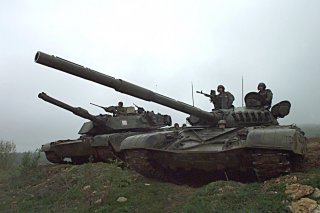M-48 vs. M-1: Which are you Rolling with?
New isn't always better.
Key point to remember: The M-1’s machine guns “can’t depress to sweep roadside ditches,” Sprey wrote. The smaller but taller M-48 carries twice as many machine-gun rounds as the M-1 does and can “sweep ditches with machine guns.”
Pierre Sprey was a member of the Pentagon team that, back in the 1970s, helped to write the requirements for the iconic A-10 attack plane.
Sprey’s advocacy of the tough, hard-hitting A-10 helped to make him famous in military-technology circles. The A-10 after all remains one of the world’s most effective close-air-support aircraft, more than 40 years after it entered service.
But some of Sprey’s other ideas are less broadly appealing. In a 2007 presentation that circulated on-line in April 2020, Sprey compared the U.S. Army’s current M-1A2 tank with the M-48, ground-combat branch’s main tank from the 1950s.
The M-48 is the better tank, Sprey insisted. Readers reacted with shock and disbelief.
Ignoring the M-1’s high speed, thick armor, powerful 120-millimeter gun and sophisticated sensors and aiming systems, Sprey instead focused on the M-48’s more fuel-efficient diesel engine and the greater flexibility of its turret-mounted machine guns.
The M-1, Sprey claimed, must spend an hour refueling for every three hours it runs, plus another hour having its filters cleaned for every two hours of operations.
The M-1’s machine guns “can’t depress to sweep roadside ditches,” Sprey wrote. The smaller but taller M-48 carries twice as many machine-gun rounds as the M-1 does and can “sweep ditches with machine guns.”
Luke O’Brien, a U.S. Army reservist and historian, pointed out what he saw as flaws in Sprey’s reasoning. “Operational mobility isn’t just a function of fuel,” O’Brien wrote. “That same mobility doesn’t mean a damned thing if you arrive with a vehicle that isn’t worth a damn.”
Also, O’Brien added, “the M-1 isn’t stopping every two hours to clean its filters.”
“The real issue is what works in combat and what does not,” Sprey claimed. “High cost and complexity usually doesn’t work.”
It’s true that, at millions of dollars per copy, a new M-1 costs more in absolute terms than a new M-48 did 70 years ago. But it’s also true that the M-1 has an extensive, and successful, combat record stretching back to the 1991 Gulf War.
While the M-1 has proved vulnerable to roadside bombs, it also has proved highly effective in tank-on-tank combat. It’s not clear the M-48 would fare better against improvised explosive devices. It’s much less clear that the M-48 reliably could beat modern tanks in direct combat.
M-48s and their variants, including newer M-60s, remain in service with several armies. Turkey has deployed M-48s and M-60s in combat in Syria. Islamic State missileers destroyed several of them.
Sprey made several other controversial comparisons in his 2007 presentation. He claimed a World War II destroyer with its torpedoes was a better surface combatant than a larger cruiser lacking torpedoes.
And of course he compared the A-10 to the F-15E fighter-bomber, concluding that the faster-turning A-10 was the better close-air-support platform.
David Axe is defense editor of The National Interest. He is the author of the graphic novels War Fix, War Is Boring and Machete Squad.
Image: Reuters

